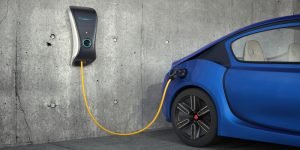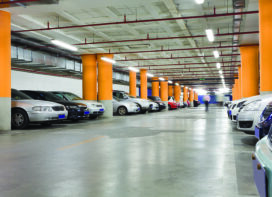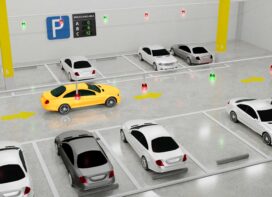As is seen in different projects around the world, the world is now looking at e-MaaS. And thus, it is only logical for us to look at e-PaaS as well. We discuss here what it might look like with electric charging taking centre stage at the parking space in shopping malls.

Although EV adoption in India is slow, due to the FAME II schemes and rising fuels costs, there is a concerted push towards EV infrastructure to accommodate the expected requirements of the future. One such institution would be the Shopping Mall. They were created on the basis of large land holdings which consolidate multiple stores in the same vicinity. And to cater to the crowds that malls attracted, large tracts of land were required for parking as well. Thus, many malls in India have more space committed to parking assets than to retail.
From a customer point of view, they can enter a safe area with good infra and can use charging time for a break or a quick recce of the mall. For long distance travellers, malls can become add in points as the range may not be enough, and a halt at a commercial centre can help both customers and the centre.
–Harpreet Singh Chhabra,
Senior VP, THE GRAND VENICE MALL
Malls and technology
At the moment, the technological services that shopping malls provide are usually relegated to automated entry-exit system. But some malls have started experimenting with automated pallet parking systems as well. Using a stack-based system, there is more optimisation of land use and reduces human interaction in the parking system. But the bigger tech revolution that malls are looking forward to is the implementation of charging infrastructure, even for the automated pallets.
Harpreet Singh Chhabra, Senior VP,THE GRAND VENICE MALL says, “Recently, we have started getting enquiries from companies wanting to set up E- charging space by blocking and booking five to seven slots on each parking level. This should be another revenue stream for the asset.”
With a large number of parking assets available with the malls, a certain section is being kept aside for electric charging. This is being executed on an experimental basis to see the viability of e-infra. But it is getting support from the governments as well. In Kerala, the Agency for Non-conventional Energy and Rural Tech (ANERT) will provide subsidies to malls that set up solar based charging stations. This would create an owned-energy model, from generation to consumption.
V.Ramesh, CEO, Varam Parking Pvt Ltd. says, “We’re seeing about 20% of every parking asset being reserved for EV chargers, which we see increasing to 60-70 % in 10 years. There is a massive growth in the two-wheeler market and multi-level parking with two-wheeler EV charging integration is also on the maps. In addition, we are trying to reduce our power costs through tie-ups with solar/wind power generation and storage.”
Combining touchless payments for entry/exit and for charging infrastructure is the most probable way forward for the industry. Self-seeking charging robots are being created as well, which would further automate the process. There is vast potential here, but this would also add to the initial setup costs.
Malls are seeing EV charging as a strong revenue model over the next 5-10 years. If you have 500-600 car parking, even if you use 25% of that for charging, it’s a big source of revenue.
–V.Ramesh,
CEO, Varam Parking Pvt Ltd.
How will MaaS figure into this?
There are two ways to look at MaaS and the future of Mobility. MaaS assumes that private transport will go down and shared vehicles will increase. But it does not imply that private ownership will cease to exist. That concept will always be around and most likely shift to private electric vehicles. So your private vehicle will require charging infrastructure, and the consumer might be tempted to spend ninety minutes in a mall every week to charge his car, rather than setup his own charging station in the house. For example, at an EV charging station in a Delhi mall, you pay Rs. 2.5 per minute for the use of a supercharger. You could leave the mall after a 90-minute shopping spree, with a full charge at a cost of Rs. 225.
From a customer point of view, they can enter a safe area with good infra and can use charging time for a break or a quick recce of the mall. For long distance travellers, malls can become add in points as the range may not be enough, and a halt at a commercial centre can help both customers and the centre.
Aviral Khandelwal,Business Head Malls and Parking, Park+ says, “In the MaaS connected system of the future, vehicle usage will be highly optimised based on the number of vehicles on the road. Parking spaces will have to provide other services such as electric charging, cleaning and maintenance to vehicles. The 4000 plus parking sites aggregated by Park+ across malls, hotels, municipalities and corporates, provide ample space, electrical load, 24×7 access and security, becoming ideal locations for deploying EV charging infrastructure. Currently, such EV zones are live across over 100 sites across major cities. Electric vehicle owners will be able to search and book electric chargers installed at these locations through phone apps.”
With the global shift toward Parking as a Service, parking operators and facility managers will need to be flexible about the usage of their properties. For instance, a corporate office can offer their parking to a mall after 6 PM and take additional parking from the mall during business hours.
–Aviral Khandelwal
Business Head Malls and Parking, Park+
Shared Mobility
The second part is to look at shared mobility. The penetration of EVs in shared mobility is expected to rise consistently over the next decade. Although the pandemic has disrupted the shared mobility model, the industry is already on the rebound in certain countries and there is strong expectation of growth. Shared EVs open up another business model for Malls to utilise their parking assets. The volume of customers that visit the mall would require a higher density of shared vehicles. And if these were EVs, they require parking and charging infrastructure, which is a source of revenue for the mall.
In addition, these shared EVs can be parked overnight and connected to slow chargers which take about 5-7 hours for a full charge. This increases your utilisation of the parking assets after the mall has shut for the public. With the EV charging station business expected to grow to $29.7 billion by 2027, there is a larger impetus for malls. They have high utilisation rates and their CAPEX for e-charging infrastructure would be lower due to reduced land acquisition costs, leading to a more profitable venture.
Ramesh has a different concern when it comes to malls.“With places like malls, the EV infrastructure has increased. If we have 25 charging stations, all of them will be drawing massive power from the main supply. So they need to be aware if their system can handle this while ramping up. This power has to have consistent flow and you can’t allow for any drop in charging while running concurrently. They have to ensure enough input power and that the cable infrastructure is strong enough to handle such kind of loads during peak hours. So many of these malls might need to revamp or take a separate line and put it in a different zone exclusive for EVs.”
Says Chhabra, “ Normally parking lots are full during weekends and long weekends. Weekdays see a good corporate traffic and evenings to nights are busy with Banquets, Cinemas and Restaurants. Parking assets can be a good environment as after the Malls close to the public, a total maintenance infra starts working and the asset is still functional. Fleets and shared vehicles can then use these hours in the parking space for their requirements.”
In general, malls are better placed to capitalise on the move to electric mobility. In metropolitan cities like Mumbai, which are tight on space for EV chargers, malls could play a vital role in this ecosystem along with corporate buildings and hotels.
Charging 500 km in 30 mins is the sweet spot that EVs need to touch, because people are fine with stopping for 30 mins for a tea or coffee break. The future isn’t going to be about huge charging stations like our current fuel pumps. It has to be combined with other things like restaurants, hotels, and malls.
 TrafficInfraTech Magazine Linking People Places & Progress
TrafficInfraTech Magazine Linking People Places & Progress





